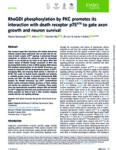Carlos Ibanez remains as NUS Visiting Professor during 2024. The last members of the group have moved on to greener pastures in Texas, Malaysia and elsewhere in Singapore. Carlos’ main research activities are now focused in his units at Peking University and Chinese Institute for Brain Research in Beijing, China, and the Karolinska Institute in Stockholm, Sweden.
|
|||||
|
How receptors juggle their interactions with multiple downstream effectors remains poorly understood. In our latest paper, we report that the outcome of death receptor p75NTR signaling is determined through competition of effectors for interaction with its intracellular domain, in turn dictated by the nature of the ligand. While NGF induces release of RhoGDI through recruitment of RIP2, thus decreasing RhoA activity in favor of NFkB signaling, MAG induces PKC-mediated phosphorylation of the RhoGDI N-terminus, promoting its interaction with the juxtamembrane domain of p75NTR, disengaging RIP2, and enhancing RhoA activity in detriment of NF-kB. This results in stunted neurite outgrowth and apoptosis in cerebellar granule neurons. If presented simultaneously, MAG prevails over NGF. The NMR solution structure of the complex between the RhoGDI N-terminus and p75NTR juxtamembrane domain reveals previously unknown structures of these proteins and clarifies the mechanism of p75NTR activation. These results show how ligand-directed competition between RIP2 and RhoGDI for p75NTR engagement determine axon growth and neuron survival. Similar principles are likely at work in other receptors engaging multiple effectors and signaling pathways. The paper has been published in EMBO Reports Read the full paper HERE Adipocyte hyperplasia and hypertrophy are the two main processes contributing to adipose tissue expansion, yet the mechanisms that regulate and balance their involvement in obesity are incompletely understood. Activin B/GDF-3 receptor ALK7 is expressed in mature adipocytes and promotes adipocyte hypertrophy upon nutrient overload by suppressing adrenergic signaling and lipolysis. In contrast, the role of ALK4, the canonical pan-activin receptor, in adipose tissue is unknown. In our latest paper, we report that, unlike ALK7, ALK4 is preferentially expressed in adipocyte precursors, where it suppresses differentiation, allowing proliferation and adipose tissue expansion. ALK4 expression in adipose tissue increases upon nutrient overload and positively correlates with fat depot mass and body weight, suggesting a role in adipose tissue hyperplasia during obesity. Mechanistically, ALK4 signaling suppresses expression of CEBPα and PPARγ, two master regulators of adipocyte differentiation. Conversely, ALK4 deletion enhances CEBPα/PPARγ expression and induces premature adipocyte differentiation, which can be rescued by CEBPα knockdown. These results clarify the function of ALK4 in adipose tissue and highlight the contrasting roles of the two activin receptors in the regulation of adipocyte hyperplasia and hypertrophy during obesity. The paper has been published in The Journal Of Biological Chemistry Read the full paper HERE ΔfosB is an alternatively spliced product of the FosB gene that is essential for dopamine-induced reward pathways and that acts as a master switch for addiction. However, the molecular mechanisms of its generation and regulation by dopamine signaling are unknown. In this new paper, we report that dopamine D1 receptor signaling synergizes with the activin/ALK4/Smad3 pathway to potentiate the generation of ΔFosB mRNA in medium spiny neurons (MSNs) of the nucleus accumbens (NAc) via activation of the RNA-binding protein PCBP1, a regulator of mRNA splicing. Concurrent activation of PCBP1 and Smad3 by D1 and ALK4 signaling induced their interaction, nuclear translocation, and binding to sequences in exon-4 and intron-4 of FosB mRNA. Ablation of either ALK4 or PCBP1 in MSNs impaired ΔFosB mRNA induction and nuclear translocation of ΔFosB protein in response to repeated co-stimulation of D1 and ALK4 receptors. Finally, ALK4 is required in NAc MSNs of adult mice for behavioral sensitization to cocaine. These findings uncover an unexpected mechanism for ΔFosB generation and drug-induced sensitization through convergent dopamine and ALK4 signaling. The paper has been published in The EMBO Journal Read the full paper HERE The medial habenula (mHb) is an understudied small brain nucleus linking forebrain and midbrain structures controlling anxiety and fear behaviors. The mechanisms that maintain the structural and functional integrity of mHb neurons and their synapses remain unknown. In this study, we used spatiotemporally controlled Cre-mediated recombination in adult mice, and found that the glial cell–derived neurotrophic factor receptor alpha 1 (GFRα1) is required in adult mHb neurons for synaptic stability and function. mHb neurons express some of the highest levels of GFRα1 in the mouse brain, and acute ablation of GFRα1 results in loss of septo-habenular and habenulo-interpeduncular glutamatergic synapses, with the remaining synapses displaying reduced numbers of presynaptic vesicles. Chemo- and optogenetic studies in mice lacking GFRα1 revealed impaired circuit connectivity, reduced AMPA receptor postsynaptic currents, and abnormally low rectification index of AMPARs, suggesting reduced Ca2+ permeability. Further biochemical and proximity ligation assay studies defined the presence of GluA1/GluA2 (Ca2+ impermeable) as well as GluA1/GluA4 (Ca2+ permeable) AMPAR complexes in mHb neurons, as well as clear differences in the levels and association of AMPAR subunits with mHb neurons lacking GFRα1. Finally, acute loss of GFRα1 in adult mHb neurons reduced anxiety-like behavior and potentiated context-based fear responses, phenocopying the effects of lesions to septal projections to the mHb. These results uncover an unexpected function for GFRα1 in the maintenance and function of adult glutamatergic synapses and reveal a potential new mechanism for regulating synaptic plasticity in the septo-habenulo-interpeduncular pathway and attuning of anxiety and fear behaviors. The paper has been published in PLOS Biology Read the full paper HERE Life- style change and anti-inflammatory interventions have only transient effects in obesity. It is not clear how benefits obtained by these treatments can be maintained longer term, especially during sustained high caloric intake. Constitutive ablation of the activin receptor ALK7 in adipose tissue enhances catecholamine signaling and lipolysis in adipocytes, and protects mice from diet-induced obesity. In this study, we investigated the consequences of conditional ALK7 ablation in adipocytes of adult mice with pre- existing obesity. Although ALK7 deletion had little effect on its own, it synergized strongly with a transient switch to low- fat diet (life-style change) or anti-inflammatory treatment (Na-salicylate), resulting in enhanced lipolysis, increased energy expenditure, and reduced adipose tissue mass and body weight gain, even under sustained high caloric intake. By themselves, diet- switch and salicylate had only a temporary effect on weight gain. Mechanistically, combination of ALK7 ablation with either treatment strongly enhanced the levels of β3-AR, the main adrenergic receptor for catecholamine stimulation of lipolysis, and C/EBPα, an upstream regulator of β3-AR expression. These results suggest that inhibition of ALK7 can be combined with simple interventions to produce longer- lasting benefits in obesity. The paper has been published in The FASEB Journal. Read the full paper HERE Prof. Carlos Ibanez leaves NUS and relocates to Beijing to direct his new research units in Peking University and Chinese Institute for Brain Research. He becomes NUS Visiting Professor from 01 January 2021. The members of the NUS group continue their research activities to wrap up ongoing projects and ready their recent findings for publication. Carlos Ibanez remains affiliated with the Karolinska Institute as part time Professor in the Department of Neuroscience. A prevalent model of Alzheimer’s disease (AD) pathogenesis postulates the generation of neurotoxic fragments derived from the amyloid precursor protein (APP) after its internalization to endocytic compartments. The molecular pathways that regulate APP internalization and intracellular trafficking in neurons are incompletely understood. In this paper, we report that 5xFAD mice, an animal model of AD, expressing signaling-deficient variants of the p75 neurotrophin receptor (p75NTR) show greater neuroprotection from AD neuropathology than animals lacking this receptor. p75NTR knock-in mice lacking the death domain or transmembrane Cys259 showed lower levels of Aβ species, amyloid plaque burden, gliosis, mitochondrial stress and neurite dystrophy than global knock-outs. Strikingly, long-term synaptic plasticity and memory, which are completely disrupted in 5xFAD mice, were fully recovered in the knock-in mice. Mechanistically, we found that p75NTR interacts with APP at the plasma membrane and regulates its internalization and intracellular trafficking in hippocampal neurons. Inactive p75NTR variants internalized considerably slower than wild type p75NTR and showed increased association with the recycling pathway, thereby reducing APP internalization and colocalization with BACE1, the critical protease for generation of neurotoxic APP fragments, favoring non-amyloidogenic APP cleavage. These results reveal a novel pathway that directly and specifically regulates APP internalization, amyloidogenic processing and disease progression, and suggest that inhibitors targeting the p75NTR transmembrane domain may be an effective therapeutic strategy in AD. The paper has been published in The EMBO Journal. Read the full paper HERE Adaptation to nutrient availability is crucial for survival. Upon nutritional stress, such as during prolonged fasting or cold exposure, organisms need to balance the feeding of tissues and the maintenance of body temperature. Mechanisms regulating the adaptation of brown adipose tissue (BAT), a key organ for non-shivering thermogenesis, to variations in nutritional state have been unknown. In this new paper, we report that specific deletion of the activin receptor ALK7 in BAT resulted in fasting-induced hypothermia due to exaggerated catabolic activity in brown adipocytes. After overnight fasting, BAT lacking ALK7 showed increased expression of genes responsive to nutrient stress, including the upstream regulator KLF15, aminoacid catabolizing enzymes, notably proline dehydrogenase (POX), and adipose triglyceride lipase (ATGL), as well as markedly reduced lipid droplet size. In agreement with this, ligand stimulation of ALK7 suppressed POX and KLF15 expression in both mouse and human brown adipocytes. Treatment of mutant mice with the glucocorticoid receptor antagonist RU486 restored KLF15 and POX expression levels in mutant BAT, suggesting that loss of BAT ALK7 results in excessive activation of glucocorticoid signaling upon fasting. These results reveal a novel signaling pathway downstream of ALK7 which regulates the adaptation of BAT to nutrient availability by limiting nutrient stress-induced overactivation of catabolic responses in brown adipocytes The paper has been published in eLife. Read the full paper HERE In this new paper, we report that CD137, a cell surface protein used in several studies as a marker for beige adipocytes, is undetectable at the protein level in beige adipocytes in vivo or in vitro, and its expression is not upregulated by adrenergic stimulation or cold exposure, as expected for a beige cell marker. Moreover, CD137 knock-out mice showed elevated levels of thermogenic markers, including UCP1, increased numbers of beige adipocyte precursors, and expanded UCP1-expressing cell clusters in inguinal WAT after chronic cold exposure. CD137 knock-out mice also showed enhanced cold resistance. These results indicate that CD137 functions as a negative regulator of “browning” in white adipose tissue, and call into question the use of this protein as a functional marker for beige adipocytes. The paper has just been published in The Journal of Biological Chemistry. Read the full paper HERE |
|||||


